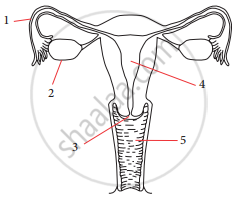Advertisements
Advertisements
प्रश्न
Choose the odd one in each of the following:
Seminiferous tubule; ovum; epididymis; sperm duct; urethra
उत्तर
Ovum
APPEARS IN
संबंधित प्रश्न
Name the function of the following:
Fimbriae
After puberty human female shows cyclic changes in her reproductive system. Explain structural and hormonal changes in the uterus.
(OR)
Give reasons :
(1) Scrotal sac serves as thermoregulator.
(2) Corpus luteum gets converted into corpus albicans in absence of fertilization.
(3) Missing of menses is the first indication of pregnancy.
(4) Surgical sterilization is a permanent method of birth control. (5) Human egg is microlecithal.
Define the following:
Parturition
Match the parts of the given figure with the correct option.

| 1 | 2 | 3 | 4 | 5 | |
| a. | Fallopian tube | Oviduct | Uterus | Cervix | Vagina |
| b. | Oviduct | Cervix | Vagina | Ovary | Vas deferens |
| c. | Ovary | Oviduct | Uterus | Vagina | Cervix |
| d. | Fallopian tube | Ovary | Cervix | Uterus | Vagina |
Which of the following is a permanent method of contraception in a human female?
When the foetus is growing inside the uterus it needs nutrients. Which part provides these nutrients?
Which among the following diseases is not sexually transmitted?
What changes are observed in the uterus if fertilisation does not occur?
With a suitable diagram, describe the organisation of mammary gland.
In absence of fertilization, corpus luteum degenerates into ______.
